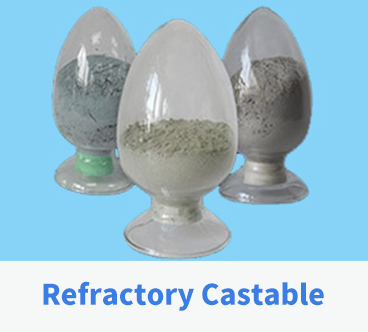Both ramming material and castable are refractory materials, but there are differences between the two.
1. The difference of raw material composition:
The ramming material is mainly an unshaped refractory material that is mainly made of aggregates and powders with a certain particle size distribution plus binders and additives, and is mainly constructed by manual or mechanical ramming. Ramming materials include corundum ramming material, high alumina ramming material, silicon carbide ramming material, carbon ramming material, silicon ramming material, magnesium ramming material, etc. For example, the bottom ramming material of an electric furnace is a bulk material made of silicon carbide, graphite, and electric calcined anthracite as raw materials, mixed with various ultrafine powder additives, and fused cement or composite resin as a binder. It is used to fill the gap between furnace body cooling equipment and masonry or masonry leveling layer.
Castable is a granular and powdery material made of refractory materials and a certain amount of binder. It has high fluidity and is suitable for monolithic refractory materials formed by casting. The three major components of castables are main components, external components and impurities, which are divided into: aggregate, powder and binder. Aggregate raw materials include silica, diabase, andesite and wax stone.
2. Differences in the scope of application of construction:
When ramming the ramming material, it is recommended to pay attention to uniform force and smooth construction. The ramming material is generally used in the kiln where the refractory bricks cannot be built or the masonry is difficult. The construction of the ramming material is relatively simple, and it is used to fill the gap between the furnace body cooling equipment and the masonry or the filling material for the masonry leveling layer. Castables are mainly used to construct integral structures such as linings of various heating furnaces. Certain premium varieties can also be used in smelting furnaces.
For example, aluminate cement refractory castables can be widely used in various heating furnaces and other thermal equipment without slag and acid and alkali erosion. In parts that are eroded by molten iron, molten steel and slag and have high working temperature, such as tapping trough, steel ladle, blast furnace body, tapping trough, etc., the cement made of low calcium and pure high alumina cement can be used. It is a refractory castable made of high-quality granular and powdery materials with high alumina content and good sintering. Another example is that phosphate refractory castables can be widely used in heating furnaces and soaking furnaces for heating metals, and can also be used in coke ovens and cement kilns that are directly in contact with materials. In some parts of metallurgical furnaces and other vessels that are in direct contact with slag and molten metal, repairing with high-quality phosphate refractory castables also has good results. To sum up, castables can be used for pouring and forming of key parts of the furnace body, such as the furnace door frame and the vicinity of the feeding port; the molten metal pouring channel is generally formed by pouring castables. After a period of use, the castables will fall off and need to be regularly repair.



